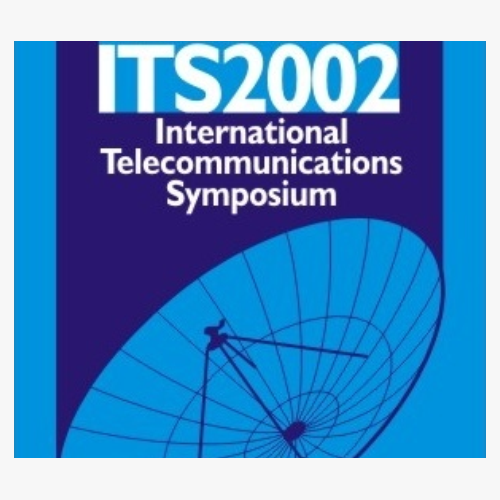
2002 International Telecommunications Symposium
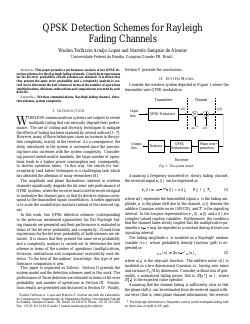
QPSK Detection Schemes for Rayleigh Fading Channels
Waslon Terllizzie Araújo Lopes, Marcelo Sampaio de Alencar
DOI: 10.14209/its.2002.264
Keywords: Wireless communications Rayleigh fading channel detection schemes system complexity
Abstract
"This paper presents a performance analysis of two QPSK detection schemes for flat Rayleigh fading channels. Closed-form expressions for the bit error probability of both schemes are obtained. It is shown that they present the same error probability and a complexity analysis is carried out to determine the best scheme in terms of the number of operations (multiplications, divisions, subtractions and comparisons) executed by each detector."Download
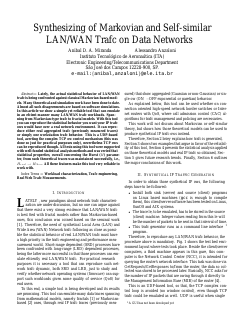
Synthesizing of Markovian and Self-similar LAN/WAN Traffic on Data Networks
Anibal D. A. Miranda, Alessandro Anzaloni
DOI: 10.14209/its.2002.269
Keywords: Workload characterization Trafc engineering Real Web Trafc Measurements
Abstract
"Lately, the actual statistical behavior of LAN/WAN trafc is being confronted against classical Markovian-based models. Many theoretical and simulation work have been done to date. Almost all such disagreements are based on software simulations. In this article we show a simple yet reliable tool that can emulate in an efcient manner many LAN/WAN trafc workloads. Spanning from Markovian-type trafc to fractal models. With this tool you can reproduce the statistical behavior you want your IP trafc ows would have over a real network environment. It can reproduce either real aggregated trafc (previously measured traces) or simply one workstation trafc behavior. This is a UDP-based tool, averting the complex TCP ow control mechanism (this was done so just for practical purposes only), nevertheless TCP ows can be reproduced though. All tests using this tool were supported with well-funded statistical analysis methods and was veried that statistical properties, overall concerning the Hurst (H) parameter, from such theoretical traces was maintained successfully, i.e., Hreal → Htheo . All these features make this tool very reliable to work with."Download

Design of a Reliable Multicast Protocol Using HW/SW Codesign Based on Performance Optimization with Genetic Algorithms
Marcio N. Miranda, Ricardo N. B. Lima, Aloysio C. P. Pedroza, Antônio C. M. Filho
DOI: 10.14209/its.2002.275
Keywords:
Abstract
"The design of a reliable multicast protocol using a methodology based on performance analysis techniques and genetic algorithms is presented. The main objective of this work is to find a faster implementation with lower costs from the HW/SW Codesign technique. The process requires a choice between the tasks to be implemented in hardware and those to be implemented in software, i.e., the selection of the best HW/SW partition. This methodology uses a genetic algorithm to optimize an error function defined by the required performance and the implementation cost of the protocol. The protocol performance is analyzed by a modelling environment called Tangram-II. The area of the hardware corresponding to a given implementation is calculated by the Synopsys tool. The methodology is intended as a tool to help protocol designers to select the best performance/cost compromise."Download
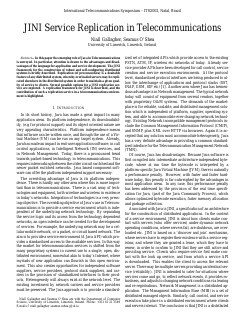
JINI Service Replication in Telecommunications
Niall Gallagher, Seamus O’Shea
DOI: 10.14209/its.2002.281
Keywords:
Abstract
"In this paper the emerging role of Java in Telecommunications is surveyed. In particular, attention is drawn to the advantages and disadvantages of the language for application and service development. The JINI framework for the construction of robust and self-configuring distributed systems is briefly described. Replication (of processes/data) is a desirable feature of any distributed system, whereby overloaded servers may be replicated elsewhere in the distributed system in order to maintain a given quality of service to clients. Several possible options for a JINI replication service are explored. A replication framework for JINI is described, and the contribution of such a replication service in a telecommunications environment is highlighted."Download

An UDP-based real time protocol for the Internet
Nestor Becerra Yoma, Juan Hood Llanos, Carlos Busso Recabarren
DOI: 10.14209/its.2002.287
Keywords:
Abstract
"Generally, real-time applications based on UDP protocol generate large volumes of data and are not sensitive to network congestion. In contrast, TCP traffic is considered \u201cwell-behaved\u201d because it prevents the network from congestion by means of closed- loop control of packet-loss and round-trip-time. The integration of both sorts of traffic is a complex problem, and depends on solutions such as admission control that have not been deployed in the Internet yet. Moreover, the problem of QoS and resource allocation is extremely relevant from the point of view of convergence of streaming media and data transmission on the Internet. In this paper a real-time protocol is proposed to employ the reduction in bandwidth allocated to TCP applications and packet-loss as desired responses to adapt the UDP packet-rate. The method is tested in a real Internet connection and seems to offer a good compromise between conservative TCP-friendly protocols, and the ordinary UDP open-loop scheme."Download
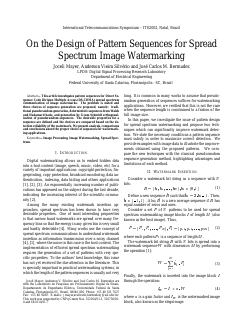
On the Design of Pattern Sequences for Spread Spectrum Image Watermarking
Joceli Mayer, Anderson Vieira Silvério, José Carlos M. Bermudez
DOI: 10.14209/its.2002.292
Keywords: Image Processing Image Watermarking Spread Spectrum
Abstract
"This article investigates pattern sequences for Direct Sequence Code Division Multiple Access (DS-CDMA) spread spectrum communication of image watermarks. The problem is stated and three choices of sequence generation are proposed, namely: traditional pseudorandom generation, deterministic sequences from Walsh and Hadamard basis, and generation by Gram-Schmidt orthogonalization of pseudorandom sequences. The desirable properties for a sequence are defined and the choices are compared based on the detection reliability of the watermark. We present analysis, comparisons and conclusions about the proper choice of sequences for watermarking applications."Download

GODZUK Cryptographic Algorithm for 3rd Generation Mobile Systems
A. C. C. Vieira, S. L. C. Salomão, A. C. Pinho, F. França
DOI: 10.14209/its.2002.297
Keywords:
Abstract
"Nowadays, data security is an important issue in telecommunication network to be considered in its implementation and operation. This paper presents the GODZUK cryptographic algorithm in a civilian and military mobile communication applications, as a possible standards chosen by 3GPP for the third generation of cellular telephony and by the Brazilian Army as its symmetric cipher algorithm in tactical and strategic communications."Download
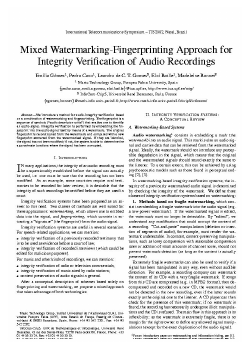
Mixed Watermarking-Fingerprinting Approach for Integrity Verification of Audio Recordings
Emilia Gómez, Pedro Cano, Leandro de C. T. Gomes, Eloi Batlle, Madeleine Bonnet
DOI: 10.14209/its.2002.303
Keywords:
Abstract
"We introduce a method for audio-integrity verification based on a combination of watermarking and fingerprinting. The fingerprint is a sequence of symbols (“audio descriptor units”) that enables one to identify an audio signal Integrity verification is performed by embedding the fingerprint into the audio signal itself by means of a watermark. The original fingerprint is reconstructed from the watermark and compared with a new fingerprint extracted from the watermarked signal If they are identical, the signal has not been modified; if not, the system is able to determine the approximate locations where the signal has been corrupted."Download

On the minimum redundancy of homophonic coding
Valdemar C. da Rocha Jr.
DOI: 10.14209/its.2002.309
Keywords:
Abstract
"This paper establishes the condition for the Rocha-Massey homophonic coding scheme to have lower redundancy than the Jendal-Kuhn-Massey scheme, for sources whose symbol probabilities are rational numbers. The condition is that each probability, in the probability distribution of the symbols of a discrete memoryless source, must contain only countably infinite binary expansions. Both schemes are briefly reviewed and the condition for achieving the minimum redundancy h(2^{-m}) in a perfect homophonic substitution scheme is determined, where h(.) denotes the binary entropy function and m is the least positive integer for which all probability entries in the expanded alphabet of the Rocha-Massey scheme have denominators which are powers of 2."Download
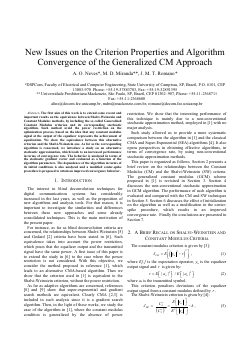
New Issues on the Criterion Properties and Algorithm Convergence of the Generalized CM Approach
A. O. Neves, M. D. Miranda, J. M. T. Romano
DOI: 10.14209/its.2002.314
Keywords:
Abstract
"The first aim of this work is to extend some recent and important results on the equivalence between Shalvi-Weinstein and Constant Modulus methods, by including the so called Generalized Constant Modulus criterion and its corresponding stochastic algorithm. Such method avoid the power restriction on the optimization process, based on the idea that any constant modulus signal at the output of the equalizer represents the achievement of equalization. We show the equivalence between this alternative criterion and the Shalvi-Weinstein one. As far as the corresponding algorithm is concerned, we introduce a study on an alternative stochastic approximation, which leads to an increased performance in terms of convergence rate. The behavior is analyzed in terms of the stochastic gradient vector and evaluated as a function of the algorithm parameters. The dependence of the algorithm in terms of its initial conditions is also analyzed and a modified center-spike procedure is proposed to attain an improved convergence behavior."Download